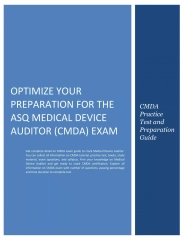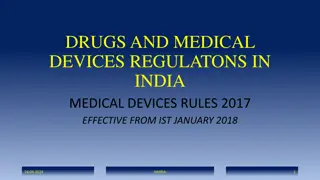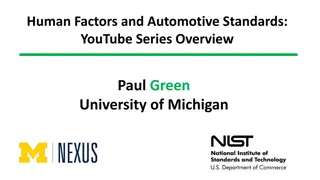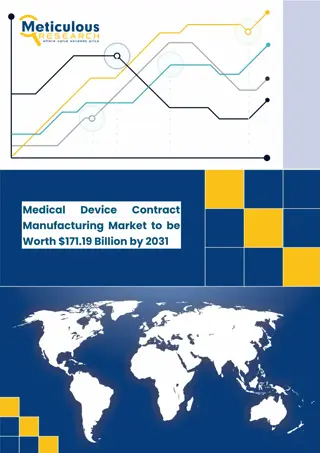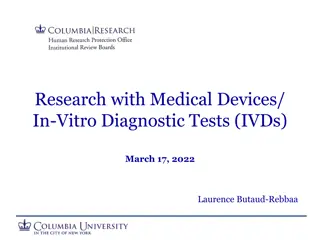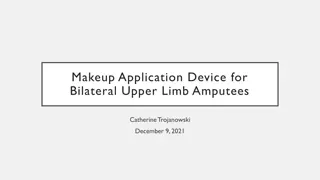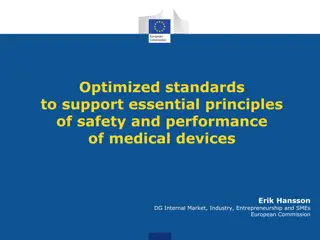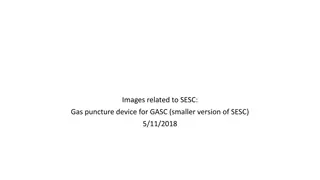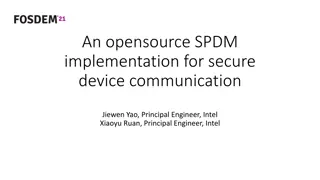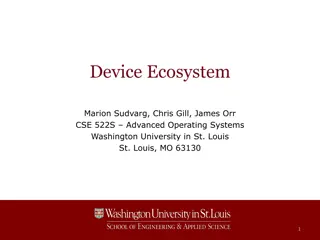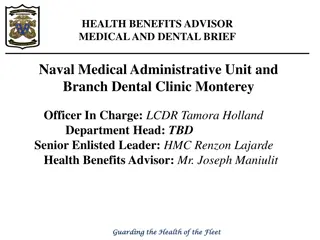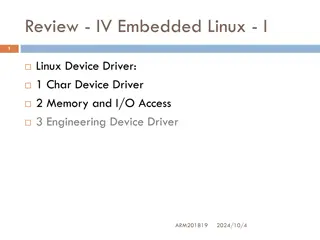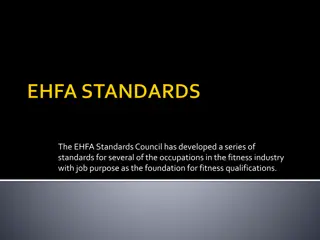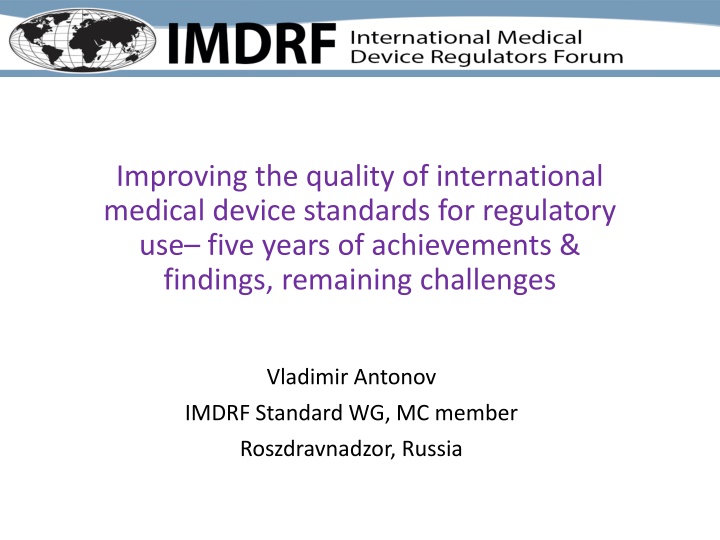
Improving International Medical Device Standards: Achievements and Challenges
The IMDRF Standards Working Group has made significant progress in enhancing the quality of international medical device standards over the past five years. This includes identifying key principles for regulatory processes and the role of international standards in ensuring safety and effectiveness. Challenges remain in harmonizing regulatory processes across different regions, as highlighted by the survey findings on the recognition of standards. The survey results indicate variations in the recognition of international standards among different jurisdictions, emphasizing the importance of aligning regulatory approaches for medical devices worldwide.
Download Presentation

Please find below an Image/Link to download the presentation.
The content on the website is provided AS IS for your information and personal use only. It may not be sold, licensed, or shared on other websites without obtaining consent from the author. If you encounter any issues during the download, it is possible that the publisher has removed the file from their server.
You are allowed to download the files provided on this website for personal or commercial use, subject to the condition that they are used lawfully. All files are the property of their respective owners.
The content on the website is provided AS IS for your information and personal use only. It may not be sold, licensed, or shared on other websites without obtaining consent from the author.
E N D
Presentation Transcript
Improving the quality of international medical device standards for regulatory use five years of achievements & findings, remaining challenges Vladimir Antonov IMDRF Standard WG, MC member Roszdravnadzor, Russia
IMDRF Standards Working Group has been created just after establishing IMDRF in 2012, understanding that principles of selection and use of standards in regulatory processes are of key importance Rationale: The GHTF (Global Harmonization Task Force) regulatory model is based on the concept that the regulation defines the essential principles (or requirements) for safety and performance (effectiveness) of medical devices. And International Standards should specify (interpret) in detail how regulatory compliance (e.g. with the essential principles) for medical devices (processes or manufacturers) could be achieved.
The GHTF document Role of Standards in the Assessment of Medical Devices GHTF/SG1/N044:2008 states: - International standards, such as basic standards, group standards and product standards, are a tool for harmonizing regulatory processes to assure the safety, quality and performance of medical devices. - Regulatory Authorities should establish a mechanism for recognizing international standards to provide manufacturers with a method of demonstrating conformity with the Essential Principles (of safety and performance). - Every Region should have established and using a list of recognized standards.
First step in SWG activity: gathering information how RA of IMDRF jurisdictions use/recognize standards for regulatory purposes. Survey on these issues was finished in 2014 by final report: IMDRF/STANDARDS WG/N15FINAL:2014 List of international standards recognized by IMDRF management committee members
Survey Procedure 1. Circulation of a list of 1102 valid international standards on Medical Devices (ISO/IEC) to USA, Canada, Australia, Japan, Brasil, China, Russia and the EU-Commission 2. Indication of the level of recognition of these standards (Y- fully recognized, N-not recognized, P-partially recognized or mandatory) by the nominated national experts 3. Compilation and assessment of the provided answers
Survey Findings The number of fully recognized standards (out of 1102 standards) varies between 261 and 44 The number of partially and fully recognized standards(out of 1102 standards) do not exceed 390 Only 2 standards are recognized by 7 of the 8 IMDRF jurisdiction Only 17 standards are recognized by 6 of the 8 IMDRF jurisdiction
Number of recognized/mandatory standards in IMDRF jurisdictions (2014) 300 250 part.rec. and man. part.rec./mand. 200 mandatory mandatory 150 part. rec. partially recogn. 100 ful. rec. fully recogn. 50 0 USA EU Canada Japan Australia Brasil China Russia 8
The results of survey indicated: (1) only small part of international standards are using for regulatory purposes; (2) there in poor uniformity in recognition/using of standards by RA of IMDRF members. Strategic goal: to promote regulatory harmonization through greater use and acceptance of international standards, ultimate goal being single IMDRF list of recognized standards. But what can be done to reach the goal(s)? It is a real challenge
2015: response of industry: GMTA initiated New Work Item Proposal creating the List of International Standards recognized by IMDRF MC Members, focusing on core horizontal standards: Identifying obstacles for not fully recognizing each standard Seting goals for full recognition of core standards. As a result of this project several IMDRF document concerning core standards have been published: - IMDRF/MC/N34 FINAL: 2015 Statement regarding Use of ISO 14971:2007 Medical devices -- Application of risk management to medical devices - IMDRF/MC/N35 FINAL: 2015 Statement regarding Use of IEC 62304:2006 Medical device software -- Software life cycle processes - IMDRF/MC/N36 FINAL:2015 Statement regarding Use of IEC 60601-1 Medical electrical equipment - Part 1: General requirements for basic safety and essential performance - IMDRF/MC/N37 FINAL:2015 Statement regarding Use of ISO 10993-1:2009 Biological evaluation of medical devices -- Part 1: Evaluation and testing within a risk management process - IMDRF/MC/N38 FINAL:2015 Statement regarding Use of ISO 11137-1:2006 Sterilization of health care products -- Radiation -- Part 1: Requirements for development, validation and routine control of a sterilization process for medical devices - IMDRF/MC/N25 FINAL:2015 Statement regarding Use of ISO 14155:2011 Clinical investigation of medical devices for human subjects Good clinical practice
But as 2018 survey shown this Work Item had no substantial effect on the common and uniform use of these standards: Comparison of core standards recognition in 2014 and 2018 Number of IMDRF jurisdictions (out of 8) who recognize standard Standard reference Title 2014 2018 IEC 62304 Medical device software - Software life cycle processes 6 6 IEC 60601-1 Medical electrical equipment - Part 1: General requirements for basic safety and essential performance 5 6 ISO 14155 Clinical investigation of medical devices for human subjects - Good clinical practice Biological evaluation of medical devices -- Part 1: Evaluation and testing within a risk management process 6 7 ISO 10993-1 6 8 ISO 14971 Medical devices -- Application of risk management to medical devices Sterilization of health care products -- Radiation -- Part 1: Requirements for development, validation and routine control of a sterilization process for medical devices 8 7 ISO 11137-1 6 7
In 2016, IMDRF MC approved a New Work Item Proposal (initiated both industry and regulators) with two goals: (1) explore how international standards can be improved; (2) increase confidence in international standards and their uniform use in medical device regulations
Concerns identified by SWG (2017): 1. Member RAs do not have sufficient awareness of Standards Developing Organizations activities, which means that RAs do not always have input and influence into standards development. If regulators are not engaged in standards development, international standards will might not be useful for regulatory purposes. 2. Current international standards frequently contain insufficient direction on how to apply them in regulatory processes. Many standards now call for a risk-based approach to the application of the standard; however, it is difficult to apply such qualitative principles to the necessary conformance measures across different country schemes used for regulatory purposes.
Example of uncertainty in acceptance criteria for regulatory purposes ISO 6710:2017 Single-use containers for human venous blood specimen collection 5 Draw volume When tested in accordance with the methods specified in Annexes A and B (Draw volume test for evacuated containers), the volume of water should be within 10 % of the draw volume. If 10 % of draw volume is not met throughout the shelf life, the manufacturer shall ensure that correct results shall be obtained. In premarket approval or market surveillance RA have to apply acceptance criteria, which are different for different types of products, but standard does not clearly provide these. Note: Draw Volume requirement for evacuated tubes with Trisodium citrate additives for coagulation testing is critical to ensure correct diagnostic test results, but practically has no influence on diagnostic performance for evacuated tubes with clot activator
Other issues identified by the SWG members include under- representation of RAs, testing houses, clinicians and academia in SDOs technical committees and working groups; participation costs (financial and human); inconsistencies in conformance testing methods across standards, and lengthy standards creation processes
Recommendations by SWG (2017): 1. Form a Standardization Network of RA Experts to develop and maintain a list of IMDRF Recognized Standards. These experts could also serve as educators and resources to other RAs and ensure that IMDRF is aware of key device standards activities. 2. Obtain formal liaison status for IMDRF to the international SDOs. This would give IMDRF access to all relevant documentation and meetings. As liaison, IMDRF may also nominate experts to participate in working groups, amplifying our ability to contribute to standards development and harmonization.
Decision IMDRF MC (2017): 1. As short term plan to focus on the development of the guidance Optimizing Standards for Regulatory Use (issued on November 2018, IMDRF/Standards WG/N51 FINAL:2018). 2. To promote relationships with ISO and IEC (liaison A status) Decision IMDRF MC (2018): The MC approved the New Work Item Proposal Update the List of International Standards Recognized by IMDRF Management Committee Members
Main purposes of our workshop is discussing the considerations of the final document IMDRF/Standards WG/N51 FINAL:2018 Optimizing Standards for Regulatory Use, as well as other issues on current progress and future plans in achieving the strategic goal of regulatory harmonization through greater use and acceptance of international standards

